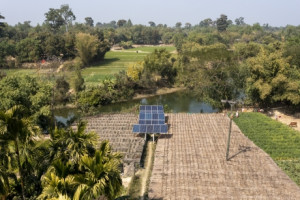
Cox's Bazar
Solar panels and green technology combat water scarcity and help farmers grow nutritious food in Cox’s Bazar
Cox’s Bazar, which has a Bangladeshi population of 2.65 million people, hosts the largest refugee camp in the world with 920 994 Rohingya who reside in 34 makeshift camps.
The high demand for firewood, housing and thatching material for the large population has intensified the demand on forest resources and has accelerated ecosystem degradation. An estimated 8 000 hectares of forest land were degraded, disrupting ecosystem services including water.
Since the Rohingya crisis began in 2017, the Food and Agriculture Organization (FAO) of the United Nations has been promoting a holistic approach to land use. Large-scale forest restoration both inside and outside refugee camps and promotion of climate-resilient agriculture and green technologies, such as solar irrigation systems, are some of the ways FAO is supporting the food security of people while conserving nature. FAO has also been working with host communities and refugees to create livelihood opportunities, providing host communities with agricultural inputs, farming equipment and capacity building.
Building household and community resilience to food insecurity and natural hazards through agricultural transformation is a key part of FAO’s mission worldwide. Supported by Bangladesh, Canada, the European Union, Japan, Netherlands, Sweden, United Kingdom and the United States of America, the programmes in Cox’s Bazar have directly benefitted 146 340 people to date.
The lush garden is a far cry from what this water-scarce area could have unfolded. Known in the news for so many other reasons than vegetables, Cox’s Bazar has nonetheless historically been a veritable oasis. The fertile ground used to make growing almost anything here an option. That has changed. Overexploitation and excessive use of chemical fertilizers and pesticides have degraded the soils. Decreasing fertility means decreasing vegetation, which means decreasing water. With the growing population, this cycle is only perpetuating and the challenges getting more severe.
In Cox’s Bazar, FAO is improving irrigation practices and crop production by tapping into green technologies, including solar energy. Currently, 70 per cent of fresh water on the planet is used for agricultural production. Solar-powered systems help reduce water loss by using buried pipe systems instead of open earth canals, which are vulnerable to evaporation and seepage.

Standing amidst rows of curated cabbages, radiant radishes and thriving tomatoes, Mohammad Islam beams. This father of three hails from Ukhiya in Cox’s Bazar, Bangladesh. Three silver panels just metres away lift their faces to the sun like sunflowers. These innocuous metal panes, solar panels installed by FAO, are largely to thank for these vegetables.
“Water scarcity is a common problem in our area, and irrigation costs are very high,” relates Mohammad. “FAO installed a solar-powered irrigation system which helps to address the problem of water scarcity.” It has also cut the production cost in half.
“Conventional irrigation practices result in huge water loss that deplete underground water reserves while increasing production costs because of the fossil fuels needed to run irrigation systems. This also leads to environmental pollution,” says Robert Simpson, FAO Representative in Bangladesh. “This initiative addresses both challenges of water scarcity and environmental impact in a sustainable way.”
FAO and Bangladesh’s Department of Agricultural Extension will replicate the initiative across the country to promote the sustainable transformation of agri-food systems.
Soaking up the sun
To learn how to use these new irrigation systems and other crop production techniques, Mohammad attended an FAO-supported Farmer Field School (FFS).
Comprised of about 20 farmers with a third of them women, the FFS encourages farmers to work as a group, manage group bank accounts, attend training sessions on good agricultural practices and adopt tailored options through on-farm experimentation.
FAO provided Mohammad with vegetable seeds and training on vegetable cultivation. His group also recently received agro – machineries including a power tiller which will boost food production and reduce their reliance on hiring labour, a difficult task during the COVID-19 pandemic.
Mohammad is now the president of his farmer group and promotes climate-smart agriculture through techniques such as integrated pest management and nature-based solutions, such as the use of pheromones and light traps, to produce pesticide-free crops.
As a platform for education and empowerment, the FFS has been a key component of FAO’s integrated programme in Cox’s Bazar, building resilient livelihoods and food security for refugees and their host communities. FAO has popularised the approach in Bangladesh, establishing around 300 FFSs, which benefit approximately 6 000 farmers in the Cox’s Bazar region.
COVID-19 and its impacts
As with many farmers worldwide, Mohammad found it a challenge to harvest his crops during the pandemic.
“During the COVID-19 lockdown, there was a shortage of labour. I struggled with getting help to work in my field. I also faced difficulties while transporting products to distant markets.”
Mohammad, however, still managed to get produce to the local markets, knowing that nutritious food was particularly important during the health crisis. He found great satisfaction in growing tomatoes, aubergines, radishes, red amaranth, cabbages and beans for other people.
“I find immense pleasure when I know that some people are staying healthy consuming the fresh vegetables that I produce.”
He also gifted some of his produce to his neighbours to help them during the COVID-19 crisis. “During the pandemic, I offered my vegetables for free to my disadvantaged neighbours,” comments Mohammad.
“I am a farmer; I grow food for myself and others. People love me, and I love my community.”
With support from community service providers and farmer leaders including Muhammad, FAO led a mass awareness campaign on how to continue agricultural activity while minimizing the risk of COVID-19.
Source: the FAO News and Media office





